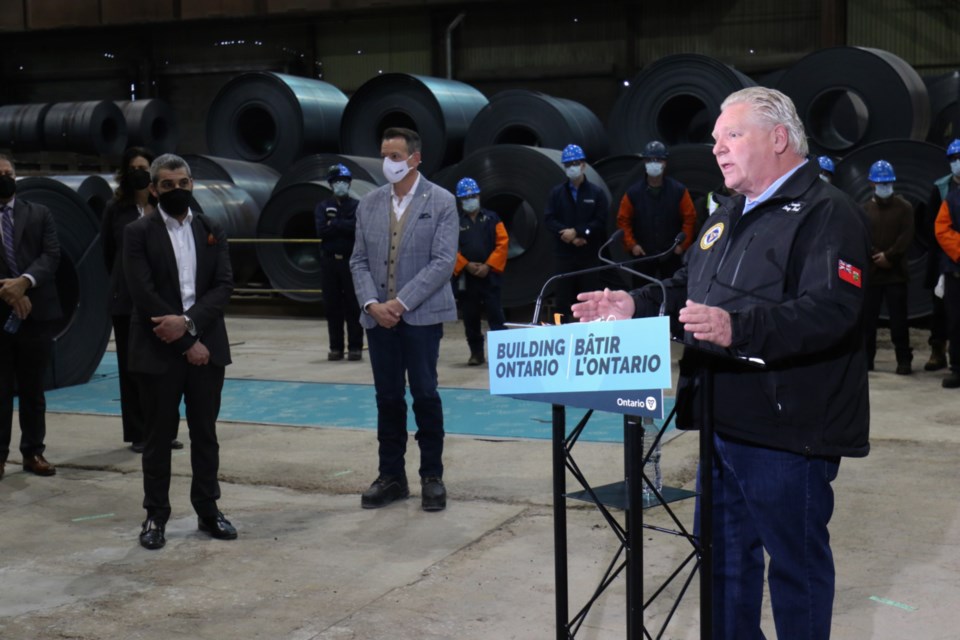Algoma Steel Inc. has been announced as the first participant in a new Ontario government program geared to make businesses more competitive on the global market by reducing their electricity costs.
The government is increasing the $120 million per year allotted to businesses through the Northern Industrial Electricity Rate program by introducing the Northern Energy Advantage Program (NEAP) in its place. The new program will see funding increased to more than $176 million by 2025-26. More businesses are able to qualify for funding and the $20 million cap for current participants is removed as part of the new program.
Ontario Premier Doug Ford, speaking at Algoma Steel Friday, said that mining, forestry and manufacturing sectors are all “energy-intensive industries that need stable electricity costs to succeed.”
“The expanded Northern Energy Advantage Program will allow more companies to qualify and control their energy costs so they can stay globally competitive and invest in creating good long-term jobs for the people of northern Ontario,” Ford said.
Sault Ste. Marie MPP Ross Romano said Friday’s announcement ensures that Algoma Steel will not suffer through the economic instability of the past as it transitions to electric arc furnace (EAF) steelmaking, a low-carbon manufacturing process of ‘green’ steelmaking that is anticipated to reduce Algoma’s environmental footprint and cut greenhouse gas emissions by 70 per cent when the $700-million conversion is complete.
“Today is about the future of Algoma Steel, it’s about the future of Sault Ste. Marie and all of northern Ontario, because today’s announcement ensures that Algoma Steel, which has been our largest employer for several generations and supported thousands of workers and their families through all of that time, will continue to be here for several generations more,” said Romano. “This demonstrates that Algoma Steel is healthy again, this demonstrates that our economy can become healthy again.”
Romano told reporters Friday that the $20-million cap under the former program is equal to an output capacity of about 600,000 tonnes of liquid steel for the Sault-based steelmaker.
“Now without the cap, it’s going to be based on how much output the plant has and the output at its top capacity would be 3.4 million tonnes of liquid steel, so on the mathematical scale, that’s somewhere in the neighbourhood of $50 million a year,” Romano said.
Algoma Steel Inc. Chief Executive Officer Michael McQuade told reporters that NEAP “further substantiates and supports the fact that we’ll be making steel here in Sault Ste. Marie for generations to come.”
“The rebate program is a function of consumption, so what it does is take the electricity price and by removing the cap, expands the ability to have that cross-competitive electricity in the quantity that we’re going to be consuming when we have two electric arc furnaces on site,” he said.
Algoma Steel is about six months into its 30-month construction plan for the conversion to electric arc steelmaking. McQuade said the pads and pilings are currently being established to support the building, and in the near future the steelmaker will be announcing the contract for construction of the building. The commissioning phase begins after construction is completed in 2024. McQuade expects both electric arc furnaces to be online by 2029.
“We’ve modelled 2029 is more or less the year when we think the local PUC upgrade as well as the provincial grid upgrade would make available that we could take advantage of the full capacity that we’re designing,” he said.
When asked if any job reductions are coming due to the conversion to EAF steelmaking, McQuade told SooToday that there will be natural attrition and retraining that Algoma Steel will address as it moves forward, and expects that the conversion will have “limited impact on the employment base.”
“It would be highly speculative, and people would latch onto that number…tell me what the price of steel is five years from now, same kind of question,” said McQuade. “It’s a fair question, but you understand the complexity.”
The Ministry of the Environment recently confirmed that Algoma Steel has submitted new ‘site-specific standards’ - a term used to describe exceptions that allow companies to emit more pollution than is normally allowed - to the Ministry of the Environment in time to meet the ministry’s March 31 deadline.
The details of Algoma’s plans have not yet been published, but they address a Jan. 7 order by the Ministry requiring the company to address non-compliance with its current site-specific standards for the harmful pollutants benzo[a]pyrene, benzene and suspended particulate matter.





















